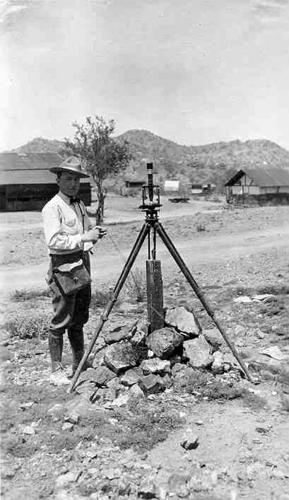Arizona mining districts originated prior to the formation of Arizona as a territory in 1863.
Except for having to pay tribute to a monarch, these self-governing regulations followed the tradition of mining laws in Europe and Mexico, including those of the 1584 Regal Ordinances and 1783 Regal Ordinances. These laws favored the right of the discoverer to work his mine as his own property with a portion — known as the “Royal Fifth” — going to the King. This occurred during the era of Spanish mining development preceding Mexican Independence in 1821.
American interest in Arizona’s mineral wealth increased after the Gadsden Purchase of 1854.
Tom Childs, Peter R. Brady and surveyor George Bartlett reported promising copper discoveries in Ajo.
Charles D. Poston, later known as the “father of Arizona” because of his support for Arizona territorial independence from New Mexico, and German mining engineer Herman Ehrenberg heavily prospected southern Arizona in search of the “planchas de plata” strike at Arizonac. This massive strike in 1736, a mile south of the current border between the U.S. and Mexico about eight miles west of Sasabe, uncovered masses of silver weighing from several hundred to several thousand pounds. Poston’s attempts at finding the strike proved unsuccessful though he did succeed in locating multiple claims in the Santa Rita and Cerro Colorado mountain ranges.
Ambiguity regarding applicable mining laws both in the U.S. and Mexico necessitated Poston’s discoveries, along with those made by others, to be protected by law. Owing provenance from groups of miners who needed some form of regulation over their discoveries in lands devoid of local government, the concept of mining districts originated during the gold rushes of California and Nevada beginning in the late 1840s. A specific geographic mineralized area usually constituted a mining district whose regulations were established by local mine operators.
The process in the formation of a mining district included a preliminary public notice to miners in the area who would meet to determine the name of the district, establish boundaries through extensive surveying and elect a president.
Early stipulations required the owner of a mining claim be a citizen of the United States. Additional specifics included claim dimensions, boundaries and duly recorded notices of the mines within the district.
Development of the claim through surface exploration, shaft sinking, underground exploration and installation of necessary equipment for mineral production was also regulated. Disputes over the boundaries of the claims were settled locally by miners who acted as judge and jury.
Early mining districts in Arizona included those of La Paz and Castle Dome. Under the guidance of Col. Jacob Snively, these areas were worked for placer gold in 1858. However, they were not officially recognized until December 1862 when hard rock mining involving more land and security costs became more prevalent.
By 1864, 25 organized districts existed in Arizona territory, including the Walker and Pioneer districts noted for their strict regulations of individual claims.
The authority of these districts was temporarily superseded by the Howell Code. It was named for Judge William Howell, who was tasked to provide a more uniform mining code for Arizona territory.
The new code was modeled after the 1783 ordenanzas de mineria of New Spain. The code itself was short-lived because it failed to legally determine the ultimate right of mineral ownership on public lands of the United States. The first federal mining law “Lode Law of 1866” superseded the code granting autonomous rule of the individual mining districts, as long as it did not conflict with the newly enacted federal law.
Today, Arizona’s mineral wealth encompasses 246 historic mining districts.
These districts serve as classification guides to Arizona’s extensive mines and mineral production. Reliable records of individual mine production are broken down by the districts wherein the mine is located.
Mining district production has since served as a valuable guide to overall metal production in Arizona mining history.





